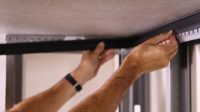Builders often find themselves between a rock and a hard place when it comes to construction defects liability. Whether the requirement be driven by construction defects law or structural and environmental concerns, liability typically falls in the lap of the builder.
One such example of building requirements driven by construction defects law is firestopping. In states with strict construction defects laws, the builder can be required to provide a 10-year performance warranty for the firestopping in residential construction. When it comes to military buildings or hospitals, builders may be required to provide a sustainable-life warranty.
For the past 25 years, the primary means and method of firestopping for metal stud gypsum construction is field applied fire caulking (aka “caulk and walk”).
Fire caulking has been the industry standard for so long that very few people would ever question its performance or longevity. In fact, most people are surprised when they come to realize that most fire sealant only provides warranty coverage ranging from six months to three years.
Is it Fair?
So how could it be that a builder could be potentially liable for firestopping of a project longer than the actual manufacturer of the fire caulking? This is just another example of the inconsistency between building industry practices and building performance requirements. This is not the fault of the fire caulking manufacturer. Caulking can only stay flexible for so long. Although, there is a wide range of flexibility and longevity among the various fire sealant manufacturers. When it comes to head-of-wall dynamic movement, a 10-year warranty is a tall order considering caulking typically dries out and loses flexibility well before 10 years has elapsed.
Coupled with the fact that once an issue arises, construction defects cases can be somewhat easy to prosecute because those that are prosecuting the case will typically go after the workmanship of the builder. The builder carries insurance and insurance companies will typically pay out or settle out of court. It’s as simple as that and once the construction defects litigation has started, it’s a long, burdensome and drawn out process. Quality builders need to be aware of this attack on their industry and livelihood.
The following are ways to limit exposure and liability:
1. Understand that workmanship will always be targeted for construction defects. Identify any scope of work that may have critical installation steps.
Example: Fire and acoustic sealant must be installed to the proper width and geometry identified by the manufacturer. The sealant joint should also utilize a backer rod or bond breaker tape to avoid 3-sided adhesion and to maximize the movement capabilities. Even though these requirements are clearly listed by the manufacturer, they are rarely installed to the letter of the specification, leaving the builder exposed to construction defects claims.
Option to limit your exposure: Look into intumescent firestopping products such as CEMCO’s FAS Track 1000 and Deflection Drift Angle that do not rely on sealant. They are easily installed and provide fire, smoke, and sound protection for dynamic head-of-wall joints.
2. Make sure the products you are installing can provide the warranty consistent with what you, as the builder, must provide for the project.
Example: Most fire sealant provides a six-month to three-year performance warranty. However, the project may require a 10-year to a sustainable life warranty. If the builder uses a product with a short-term warranty and the project requires a long term warranty, there is little the firestopping manufacturer can do once their warranty has expired.
When you take a step back and look at the situation, it does not seem fair that the installer could be liable for a product that does not perform to the project specifications. However as most builders already know, once you install it you own it. So it is important to consider all of your firestopping options.
Option to limit exposure: Look for firestopping products that do not solely rely upon materials that provide only short term solutions. Intumescent firestopping products can provide much longer warranties whether they are used for pipe penetration or for dynamic head-of-wall joints. There are several options out there to consider.
3. Make sure the building products you are using can meet the performance requirements of the project.
Example: Seismic zones, expanding soils, structural loading requirements have all increased the amount of deflection movement required in today’s construction industry. This type of movement takes place at the head-of-wall joint and will greatly affect which HW-D-#### UL joint system reports can be utilized.
If a project requires 1” downward compression movement and you are using full fire caulking fill material, it will be difficult if not impossible to find a UL HW-D-#### joint system that can provide that type of movement.
Be sure that the UL HW-D-#### joint system reports you submit for your project can provide the required deflection movement. Finding out that your submitted UL HW-D-#### will not provide enough movement once the project has started and the walls are built can greatly impact your schedule and your bottom line if you find out that you have to switch out your firestopping.
Unfortunately, this disconnect between the architect and the structural engineers happens way too often. It typically happens when the architect uses a generic copy and paste head-of-wall detail in the project drawings and then calls out a particular firestopping manufacturer in the specifications that completely contradicts the deflection criteria for the project.
Option to limit exposure: Look into 100 percent movement joint systems. One hundred percent joint systems allow for free range movement so a 1/2-inch installed joint with 100 percent compression or extension will provide 1 inch of total movement.
4. Quality of Life issues often lead to construction defects claims.
Example: Cracks in the wall assembly, whether it be on the exterior walls or interior walls, can be an eye sore and if there are highly visible cracks, lawyers may be eventually called. Cracking typically occurs vertically on interior walls when control joints are not properly utilized and cracks near or at the interior head-of-wall joint occur when the joint material is too rigid or the joint width is too small.
Option to limit exposure: Look for products that will provide flexibility at dynamic head-of-wall joints that will minimize or eliminate cracking. A vinyl deflection bead or a flexible Denver Foam backer rod with flat tape and joint compound are two ways to add flexibility to a head-of-wall joint. Properly located control joints will also greatly reduce vertical cracking. If the wall assembly is fire rated, using a fire rated control joint such as FAS-093X will eliminate extra build up within the wall.
Closing
As you are building any project, try to visualize what would happen if a third party consultant was to tear back into your work. Are you 100 percent confident that they will find nothing wrong with your installation?
Protect yourself by limiting your exposure to products or materials that may be difficult to install or that provide insufficient warranties.














